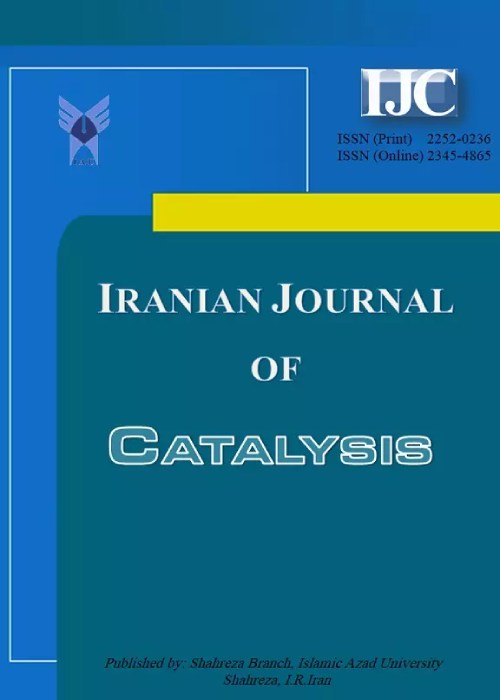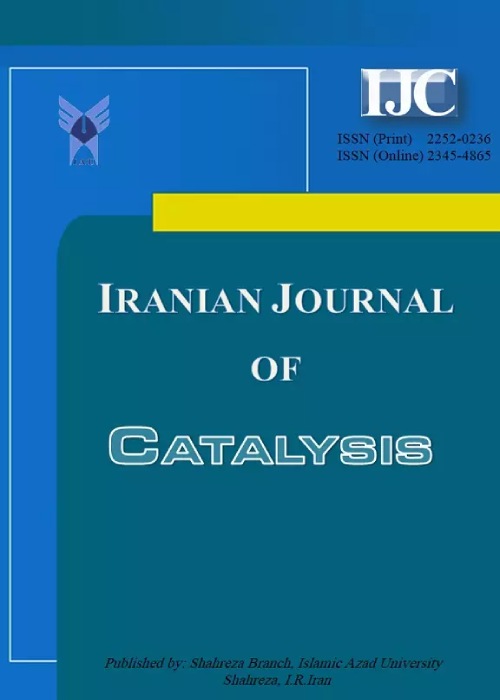فهرست مطالب

Iranian Journal of Catalysis
Volume:13 Issue: 2, Spring 2023
- تاریخ انتشار: 1402/04/10
- تعداد عناوین: 11
-
-
Pages 113-123
Due to a significant increase in the demand for usable power, research focused on energy-material relations has garnered considerable attention. Fuel cells, characterized by their high efficiency, high energy density, quiet operation, and environmental friendliness, are regarded as a promising future power source that provides clean power at the point of use. The incorporation of functionalized graphene quantum dots (GQDs) has been shown to enhance catalytic activity and stability, making them attractive materials for various device applications, particularly in fuel cells. This review presents an overview of different synthesis methods for GQDs and discusses the utilization of GQD-doped composites with optimized content and enhanced electro conductivity as electrocatalysts in fuel cells.
Keywords: fuel cell, Graphene Quantum Dot, Electro catalyst, Conductivity -
Pages 125-133In this work, the Response Surface Methodology (RSM) was investigated by applying the Design of the Experiment in normal heptane isomerization. The design was guided to three surface responses on the dependency of normal heptane conversion, isomerization selectivity, and research octane number on the reaction temperature (200 - 350 °C), the weight percentage of protonated Zeolite Socony Mobil–5 (HZSM-5) zeolite in catalyst structure (10 - 40 weight percent) and time on stream (1 - 6 h). The Analysis of Variance for Pt-supported micro/mesoporous catalysts indicated that the reaction temperature was the prominent significant variable in normal heptane conversion, the development of isomers, and research octane number followed by weight percent of HZSM-5 and time on stream. The optimum research octane number predicted from the response surface analysis is ~ 61 at the reaction temperature of 350 °C, weight percent of HZSM-5 of 25%, and time on stream of 1 h.Keywords: Analysis of Variance, Design of Experiment, n-Heptane isomerization, response surface methodology, Research octane number
-
Pages 135-155Synthesis of Ni/SiPILC (Silica Pillared Clay) catalyst based on light fraction clay for hydrocracking of High-density Polyethylene (HDPE) plastics into liquid fuels has been carried out. The SiPILC was synthesized using CTAB and TEOS by varying the TEOS/clay mole ratio. The Ni metal was impregnated on the SiPILC with a variation of 2, 4, 6, and 8 wt% of Ni. Hydrocracking of HDPE plastic was carried out using catalysts in a semi-batch stainless steel reactor. The liquid cracking product was analyzed using GC-MS. The results showed that the clay consisted of Montmorillonite, Cristoballite, and Quartz minerals. The highest specific surface area of 571 m2/g was showed by the SiPILC treated by TEOS/clay mole ratio of 60. Ni 2%/SiPILC achieved the best performance catalyst with the highest acidity of 1.327 mmol/g that produced a liquid fraction of 45.50% (gasoline 55.03 % and diesel 44.96 %) at hydrocracking temperature 450 oC for 1.5 h. The Ni 2% /SiPILC catalyst still performed well after the fifth hydrocracking run, producing a liquid fraction of 41.08 %.Keywords: Pillared clay, silica pillars, HDPE hydrocracking, Ni catalyst, Plastic waste
-
Pages 157-167Fe is an important element, used in soft magnetic materials (cores) in electrical and electronic devices and its concentration in e-waste is high. Thus, this study is aimed to recover Fe from the soft magnetic FeSiAl cores of spent printed circuit boards (PCBs). Here, the Fe-rich FeSiAl cores were identified, separated manually, and subjected to dissolution in citric acid (100 mM) and ascorbic acid (10 mM) mixture at 80 °C. The dissolved Fe was selectively precipitated as Fe3O4 using 20% NaOH in an N2 atmosphere at 90 °C for about 60 min. The obtained Fe3O4 shows ferromagnetic behavior with 30 emu/g saturation magnetization at 300 K. The BET surface area of Fe3O4 NPs was found to be 71.656 m2 g-1. Furthermore, the Fe3O4 NPs were utilized for methylene blue degradation with H2O2 in visible light irradiation. At optimum conditions, such as 10 ppm MB solution, 0.1 mL H2O2, and an S:L ratio of 0.05 g/L about 100% degradation was achieved in about 45 min under visible light irradiation and the correlated rate constant is 0.084 min-1. We believe that the synthesis of value-added compounds directly from the dissolution medium is an environmentally benign step toward resource recycling.Keywords: Citric acid, ascorbic acid, Fe3O4, Spent PCBs, Soft magnetic FeSiAl cores
-
Pages 169-176This paper deals with the comparison of the Cr (III) dopant from tannery wastewater to the Cr (III) from the pure salt solution on the character and activity of TiO2. The doping was conducted by hydrothermal method, and the Cr-doped TiO2 prepared was characterized by UV specular reflectance (SRUV), X-ray diffraction (XRD), and X-ray fluorescence instruments. The effect of the Cr (III) doping on the activity of the TiO2 was evaluated by Congo red photodegradation. The research results reveal that Cr (III) doping on TiO2 has been successfully reducing remarkably the band gap energy (Eg) from 3.13 eV to 2.64 eV, shifting into the visible region, and further noticeably improving TiO2 activity. The effect of the Cr (III) doping from the wastewater is found to be slightly higher than that of the salt solution. The highest degradation of 10 mg/L Congo red in 50 mL solution, can be reached by applying 30 mg of the photocatalyst in 60 mins and at pH 7.Keywords: Congo red dye, Cr, doping, Photodegradation, Tannery wastewater, TiO2
-
Pages 177-185The Manganese complex of meso-tetrakis (4-carboxyphenyl) porphyrin was immobilized onto the surface of functionalized activated carbon and used as a heterogeneous catalyst for the oxidation of different alkenes. The heterogenized catalyst has been fully characterized using Ultraviolet–visible (UV-Vis), Fourier-transform infrared (FTIR), and atomic absorption spectroscopies as well as thermogravimetric analysis (TGA), scanning electron microscopy (SEM), and nitrogen adsorption-desorption (BET method) analyses. The Catalytic activity of the catalyst was investigated in the epoxidation of alkenes with H2O2 as a green oxidant. The influence of different parameters including time of reaction, molar ratio of catalyst, imidazole, and amount of oxidant on the efficiency of the catalyst was investigated. Complete conversion of the indene, α-methyl styrene, and 4-methyl styrene was achieved after 4 h at room temperature.Keywords: catalyst, Manganese porphyrin, Amine functionalized activated carbon, Epoxidation
-
Pages 187-199In the present work, first, magnetic nanoparticles (MNP) were synthesized, and a layer of silica was placed on the magnetite nanoparticles through the reaction with TEOS. Next, the pyridine-2-(1H)-tetrazole ligand was fixed on the core-shell magnetite nanoparticles, and finally, the nanocatalyst copper complex was synthesized. The synthesized copper (II) complex of magnetic nanocatalyst was identified through different analyses such as FT-IR, SEM, EDX, XRD, VSM, BET, and atomic absorption. After characterizing the nanocatalyst Fe3O4@SiO2-(CH2)3-Pyridine-2-(1H)-tetrazole-Cu(II), by applying this catalyst in the reaction of benzaldehyde with 4-hydroxycoumarin, the reaction conditions such as solvent type, reaction temperature and The amount of catalyst was optimized. Ethanol was chosen as the optimal solvent as an environmentally friendly solvent. The recycling cycle of the magnetic catalyst was also studied, and the slight decrease in the catalyst's efficiency after six times reactions indicates the high efficiency of this nanocatalyst in the synthesis reaction of bis-coumarin derivatives as a green catalyst.Keywords: coumarin, Bis-coumarin, aldehyde, Magnetic nanocatalyst, Copper catalyst
-
Pages 201-210A novel organic-inorganic hybrid nanomaterial was fabricated by anchoring an organic constituent possessing a 4,4′-bipyridine framework to nano-silica (as an inorganic constituent). The nanomaterial, namely 1-(Si-pr)-[4,4′-bipyridine]-1,1ʹ-diium dihydrogen phosphate anchored to nano-silica (SPBDS), was characterized by EDS, elemental mapping, FE-SEM, FT-IR, XRD, and TG analyses. Thereafter, bis(pyrazolyl)methanes were successfully constructed through the solvent-free reaction of 3-methyl-1-phenyl-1H-pyrazol-5(4H)-one (2 eq.) and aryl aldehydes (1 eq.) using SPBDS. The catalyst was reusable nine times without a significant decrement in its performance.Keywords: Organic-inorganic hybrid nanocatalyst, 1-(Si-pr)-[4, 4′-bipyridine]-1, 1ʹ-diium dihydrogen phosphate anchored to nano-silica (SPBDS), Bis(pyrazolyl)methane, Solvent-free
-
Pages 211-222Perovskite oxides possessing high stability and composition adjustability are effective in many applications. The La2BMnO6 (B=Co, Ni) double perovskite oxides were synthesized using the sol-gel method and deposited on MgO support (loading = 10, 20, and 30 wt. %) using a mechanical mixing method by an ultrasonic device. The elaborated samples were investigated for application in propane deep oxidation. The catalytic performance of these catalysts was analyzed by a variety of characterization techniques such as XRD, SEM, FTIR, TEM, and H2-TPR. Ni-containing catalysts were found to have superior catalytic activity than the sample containing Co. The lowest catalytic activity belonged to the cobalt-containing double perovskite with 10 wt.% loading on MgO support, while the highest conversion was related to the 20La2NiMnO6/MgO composite oxide with T90 = 434 °C. The support showed a positive impact on the performance of the catalysts. Deposition of a certain amount of perovskite oxides on the support boosted the specific surface area of the catalyst and, therefore, combined with improved reducibility, improved propane catalytic degradation.Keywords: Double perovskite oxide, Support, Composite oxide, catalytic combustion, propane
-
Pages 223-228AmirMahdi Tavassoli was born in 1994 and holds a Diploma in Mathematics with excellent grades and a bachelor’s degree in applied chemistry from the university of Malayer. During his Bachelor's, he worked on decolorizing organic compounds. AmirMahdi completed his master’s degree in organic chemistry from the university of Bu-Ali Sina under the supervision of Professor Mohammad Ali Zolfigol, where he worked on magnetic nanoparticles and ionic liquids to synthesize organic compounds in the laboratory of organic chemistry. During this time, he participated in more than five national organic chemistry seminars. He continues his scientific research and works on multicomponent reactions and covalent organic frameworks.Keywords: Single atom catalyst, SACs, Organic Methodologies, Organic chemistry
-
Pages 229-234Milad Mohammadi Rasooll was born in Hamedan, Iran in 1995. He received his B.Sc. in pure Chemistry (2018) from Bu-Ali Sina University, Iran. He received his M.Sc. in Organic Chemistry (2021) under the supervision of Prof. Mohammad Ali Zolfigol. He was also accepted into a Ph.D. program in organic chemistry at the Bu-Ali Sina University in the same year. His research interest is the synthesis, characterization, and applications of homogeneous and heterogeneous reagents and catalysts in organic synthesis.Keywords: Carbon Quantum Dots, nano catalyst, Heterogeneous catalysis, Suzuki reactions


